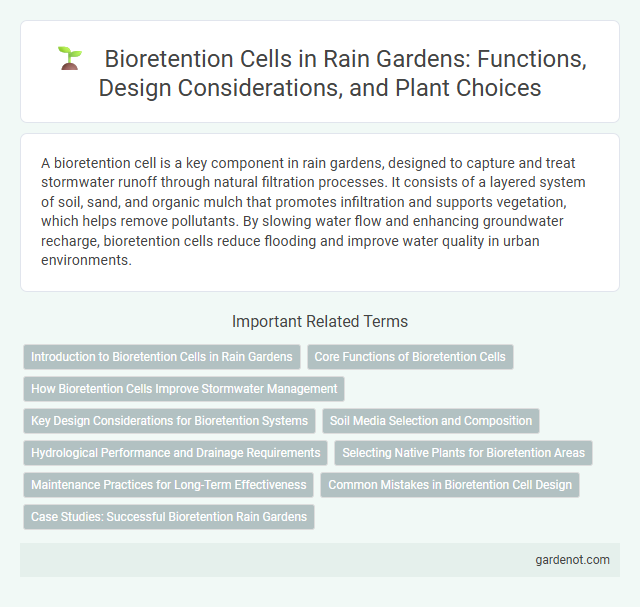A bioretention cell is a key component in rain gardens, designed to capture and treat stormwater runoff through natural filtration processes. It consists of a layered system of soil, sand, and organic mulch that promotes infiltration and supports vegetation, which helps remove pollutants. By slowing water flow and enhancing groundwater recharge, bioretention cells reduce flooding and improve water quality in urban environments.
Introduction to Bioretention Cells in Rain Gardens
Bioretention cells in rain gardens are engineered landscape features designed to manage stormwater runoff by filtering pollutants through soil layers and vegetation. These cells enhance water quality by capturing and infiltrating rainwater, reducing runoff flow and volume. Incorporating native plants and porous soil media, bioretention cells promote groundwater recharge and support local ecosystems.
Core Functions of Bioretention Cells
Bioretention cells are engineered to capture and treat stormwater runoff by promoting infiltration and pollutant removal through soil filtration and plant uptake. These systems reduce peak flow rates, enhance groundwater recharge, and improve water quality by trapping sediments, nutrients, heavy metals, and pathogens. Vegetation within bioretention cells stabilizes soil, supports microbial activity, and contributes to evapotranspiration, further mitigating urban runoff impacts.
How Bioretention Cells Improve Stormwater Management
Bioretention cells improve stormwater management by filtering runoff through engineered soil layers and vegetation, which remove pollutants and reduce water temperature. These cells enhance infiltration, decreasing surface runoff and mitigating flooding risks in urban environments. By promoting groundwater recharge, bioretention cells support sustainable water cycles and protect natural waterways from contamination.
Key Design Considerations for Bioretention Systems
Bioretention cells require careful design to optimize stormwater infiltration and pollutant removal, emphasizing soil permeability, plant selection, and hydraulic loading rates. Proper grading and underdrain placement prevent waterlogging while facilitating efficient drainage, enhancing the system's longevity and effectiveness. Incorporating native vegetation with deep root systems improves soil structure and maximizes nutrient uptake, critical for maintaining water quality and supporting local biodiversity.
Soil Media Selection and Composition
Selecting the appropriate soil media for bioretention cells is critical to ensure optimal stormwater infiltration and pollutant removal. Ideal soil media typically consists of a balanced mix of sand, compost, and topsoil, providing sufficient permeability while supporting healthy plant growth and microbial activity. Proper soil composition enhances water retention capacity, nutrient filtration, and prevents clogging, which is essential for maintaining the long-term functionality of a rain garden.
Hydrological Performance and Drainage Requirements
Bioretention cells significantly enhance hydrological performance by capturing and infiltrating stormwater runoff, reducing peak flow rates and improving water quality through natural filtration. These systems require well-designed drainage with layered soils, engineered media, and adequate underdrain systems to ensure proper infiltration while preventing waterlogging. Incorporating native vegetation maximizes evapotranspiration, supporting sustainable water balance and meeting urban drainage requirements efficiently.
Selecting Native Plants for Bioretention Areas
Selecting native plants for bioretention areas enhances rain garden functionality by improving water infiltration and pollutant removal. Native species such as Carex pennsylvanica, Juncus effusus, and Asclepias tuberosa are well-adapted to local climate and soil conditions, promoting habitat diversity and requiring less maintenance. These plants support soil stabilization, reduce erosion, and provide critical habitat for pollinators, maximizing ecological benefits within bioretention cells.
Maintenance Practices for Long-Term Effectiveness
Regular inspection and removal of accumulated sediment and debris in a bioretention cell prevent clogging and maintain optimal infiltration rates. Periodic pruning and replacement of plants ensure healthy vegetation that supports pollutant uptake and soil stabilization. Monitoring water flow patterns and repairing erosion damage sustain the rain garden's capacity to manage stormwater effectively over time.
Common Mistakes in Bioretention Cell Design
Common mistakes in bioretention cell design include inadequate sizing, poor soil media selection, and lack of overflow control, leading to reduced water infiltration and potential flooding. Improper vegetation choice can result in plant failure and decreased pollutant removal efficiency. Ensuring appropriate hydraulic loading rates and incorporating well-designed underdrains are critical for optimal stormwater management and long-term bioretention cell performance.
Case Studies: Successful Bioretention Rain Gardens
Bioretention cells have proven effective in multiple case studies by significantly reducing stormwater runoff and improving water quality through natural filtration processes. Projects in urban areas like Seattle and Melbourne demonstrate 40-60% reductions in peak flow rates and removal of up to 80% of suspended solids. These successful implementations highlight bioretention rain gardens as essential infrastructure for sustainable urban drainage systems.
Bioretention cell Infographic

 gardenot.com
gardenot.com